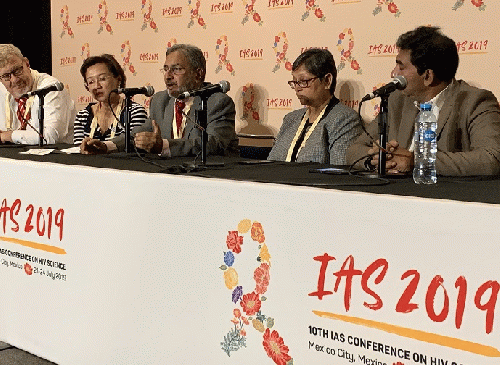
Undetectable equals untransmissible has to be a reality in every person living with HIV's life
(Image by CNS (Citizen News Service citizen-news.org)) Details DMCA
It has been 38 years and 1 month since the first case of HIV infection was detected in 1981, reminded Dr Anthony Fauci, Director of US National Institute of Allergy and Infectious Diseases (NIAID) at the 10th IAS Conference on HIV Science (#IAS2019) taking place in Mexico City. Dr Fauci is a recipient of Robert Koch Award and US Presidential Medal for Freedom.
Over 5000 delegates form 140 countries have converged at IAS 2019 to address issues around the global response to AIDS. "We have indeed come a long way. Life expectancy for a 20 year old newly diagnosed with HIV was 1-2 years in the 1980s but is now around 53 years if on ART", he shared.
Historic obligation to 39 million people who died of AIDS
We now have the knowledge, expertise and evidence-based tools to prevent transmission of HIV (like Pre-Exposure Prophylaxis (PrEP), Prevention of Parents to Child Transmission of HIV (PPTCT), treatment as prevention, medical male circumcision, condoms, among others) as well as simple to take ART, which allows HIV control for all, said Dr Juergen Rockstroh, Professor of Medicine, University of Bonn, Germany. For him ending the AIDS epidemic is more than a historic obligation to the 39 million people who have died of the disease. It also represents a momentous opportunity to lay the foundation for a healthier, more just and equitable world for future generations.
Just 17 months to bridge the gap
Yet, despite all this, as per the latest UNAIDS report, there are 37.9 million people living with HIV (PLHIV) out of which 14.6 million are still not able to access antiretroviral therapy (ART). In 2018 there were 1.8 million new infections (5,000 new HIV infections each day) - which was just 0.1 million less as compared to 2017. Thus global reduction in new HIV infections are off the 90-90-90 targets for 2020. It has to be brought down to 0.5 million by 2020 in order to achieve the 90-90-90 targets of UNAIDS. In fact, there is a gap of of 7.7 million to reach all the three 90s of these targets. And we have just 17 months to bridge this gap.
"It is high time to set our eyes, not on just the 2020 targets but on the targets to end AIDS by 2030, which are 100% of people living with HIV must know their status, 100% of people living with HIV must get ART, and 100% of HIV positive people must be virally suppressed and new HIV transmission rate must be zero", said Dr Ishwar Gilada, Governing Council member of International AIDS Society (IAS) and President of AIDS Society of India.
While conceding that some places (like Thailand, Malawi, New South Wales, London and San Francisco) have dramatically reduced HIV incidence and mortality, Dr Adeeba Kamarulzaman, President-elect of IAS and Dean, Faculty of Medicine, University of Malaya, Malaysia, rued that there are many countries where uptake and scale up of prevention and treatment programmes have been slow. She cited HIV associated stigma, criminalisation of sex work and of men who have sex with men, lack of sustainable funding and political inertia, as the biggest barriers in implementing evidence-based interventions to prevent and treat HIV.
(Note: You can view every article as one long page if you sign up as an Advocate Member, or higher).





